
Lab
to Get Unique X-Ray Microscopy Resource
New Plan Increases
Workplace Safety Where Lab and UC Berkeley Campus Interface
Lab to Get Unique X-Ray Microscopy Resource
BY LYNN YARRIS
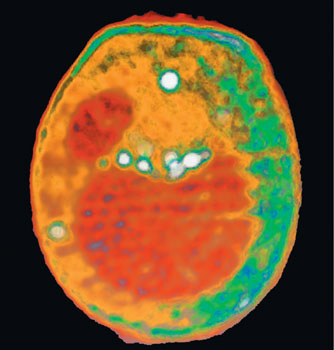 |
|
| This x-ray tomography image of a yeast cell taken at the ALS with XM-1 is an example of what could be done with the proposed XM-2. Internal organelles are color-coded according to x-ray absorption with the nucleus and large vacuole shown as red, lipid droplets as white, and other cytoplasmic structures as either orange or green. |
A first-of-its-kind x-ray microscope being built for the Advanced Light Source (ALS) holds forth the promise of “cat scans” for biological cells, and other unprecedented capabilities for cell and molecular biology studies. This could lead to a better understanding of human diseases at the molecular level and possibly new discoveries for treating those diseases. Now, researchers with Berkeley Lab and University of California San Francisco (UCSF), have received grants from the National Institutes of Health (NIH) and the U.S. Department of Energy (DOE) to build and operate this microscope.
“X-ray microscopy is an emerging new technology that will expand the existing imaging toolbox for cell and molecular biologists,” says cell biologist and microscopy expert Carolyn Larabell, who holds a joint appointment with Berkeley Lab’s Physical Biosciences Division and UCSF’s Anatomy Department. She’s the principal investigator for this project. Berkeley Lab physicist Mark Le Gros is the co-principal investigator.
“Although there are currently many powerful techniques for imaging biological cells, each with its own unique strengths and limitations, there remains a gap between the information that can be obtained with light microscopy and electron microscopy,” Larabell says. “X-ray microscopy can bridge the gap by combining some of the best features associated with light and electron microscopy, plus bringing in some entirely new capabilities.”
To build this new microscope, Larabell and Le Gros have been awarded $2.5 million from NIH and DOE. The money will be dispersed to UCSF through NIH’s National Center for Research Resources (NCRR). Under the terms of the NCRR grant, Larabell and Le Gros will establish a Biomedical Tech-nology Resource Center at the ALS, which means the instrument will be available to biomedical researchers throughout the nation. Together, NIH and DOE will contribute about $1.3 million to run the microscope for each of its first five years of operation. The grants can then be renewed for additional five-year periods.
What Larabell and Le Gros have proposed is a transmission x-ray microscope (TXM) off an ALS bend magnet beamline. The new TXM will be able to image whole, hydrated cells at resolutions of about 35 nano-meters and specific structural elements within the cell at a resolution of at least 25 nanometers. Future improvements could put the resolution of this microscope as fine as 10 nanometers, which is about the size of a protein.
Imaging data will be collected at breathtaking speed compared with the time-consuming procedures required to collect data via electron microscopy. Obtaining a complete data set for an x-ray tomography image should require less than three minutes, compared to the days and even weeks required for electron microscopy.
“We’ll be able to collect data faster than we can process it,” Larabell says. “We’ll be able to examine whole cells, identify subcellular components and locate macromolecules inside cells at substantially better resolutions than light microscopy and without the elaborate specimen preparations needed for electron microscopy.”
Microscopy using photons that fall within the visible light region of the electromagnetic spectrum remains the workhorse of biology because it enables scientists to examine living cells in their natural state. Resolution, however, is typically no better than 200 nanometers, and that is only when the light is focused on a single spot.
Microscopy techniques based on the use of electrons can provide images at a resolution of five nano-meters or better. However, samples must be sliced thin and put through an elaborate chemical preparation and stained in order for the electrons to penetrate and yield high-resolution images.
With transmission x-ray micro-scopy, samples are rapidly frozen and need no further chemical alteration or staining to be imaged. Further-more, 3-D subcellular structures within 10 nanometers of one another can be captured in the same image, which means interactions between two or more proteins can be observed.
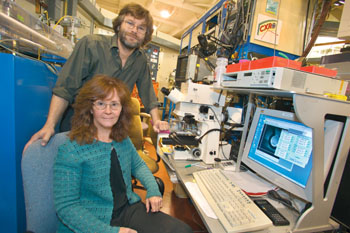 |
|
| Carolyn Larabell and Mark Le Gros used the current transmission x-ray microscope at the ALS, XM-1, to demonstrate the potential of their proposed microscopy resource. | |
Larabell and Le Gros have been using an existing TXM at the ALS to demonstrate the potential of using this technology in cell and molecular biology studies. The existing TXM, called XM-1, was designed and is operated by Berkeley Lab’s Center for X-ray Optics primarily for the study of materials. The new TXM, dubbed XM-2, will be optimized for biology and will therefore have several advantages, including improved zone plates, the optic devices composed of nanometer-scale concentric metal rings that are used to focus x-rays for imaging purposes.
“Whereas XM-1 could only be used to study suspension cell lines, XM-2 can be used to study adherent cell lines as well,” says Larabell. “In addition, we’ll have greater energy tunability with XM-2, which means it can be used to do imaging of thicker samples as well as high-res images of thinner samples just by spinning to a different zone plate.”
XM-2’s ability to use a multiple choice of x-ray beam energies will also open the door to multiple labeling of proteins. This means scientists will be able to use the microscope to study protein complexes as well as individual proteins. XM-2 should also prove to be a powerful tool for utilizing tomographic imaging techniques in x-ray microscopy.
“No contrast enhancement reagents were used, the cells were not embedded or sectioned, and collection of the entire data set took less than an hour,” says Larabell of the XM-1 demonstration studies. “While our resolution was not quite as good as that from cryo-electron tomography, it was more than sufficient for many of the scientific questions being asked. Also, we’ve not yet reached the limit of resolution that’s theoretically possible with x-ray tomography.”
Under the terms of the NIH-NCRR grant, XM-2 is expected to be up and running at the ALS in 2006.
Says Le Gros, “This new resource will further strengthen Berkeley Lab’s world leadership in x-ray microscopy.”
New Plan Increases Workplace Safety Where Lab and UC Berkeley Campus Interface
BY RON KOLB
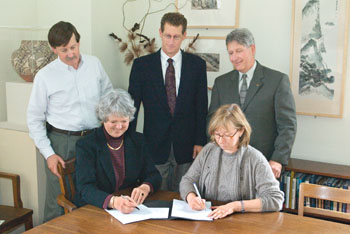 |
|
| From left to right are Lab EH&S staffer John Seabury, Vice Chancellor for Research Beth Burnside, UC Berkeley EH&S Director Mark Freiberg, Lab EH&S Director Robin Wendt, and Lab Deputy Director Sally Benson. Not shown, Joyce Freedman, Assistant Vice Chancellor for Research Administration and Compliance. |
Hundreds of Berkeley Lab employees who also use Berkeley campus space and equipment as part of their work will have to pay a bit more attention to workplace safety, under an agreement signed recently by both institutions.
The renewed partnership pact between the Lab and UC Berkeley on managing policies in environment, health and safety clarifies responsibilities and accountability for those whose worlds include both sites.
Safety is one area in which such differences in location or, in some cases, regulations and policies, cannot be permitted to affect the quality of the work at either site. That’s one reason why Berkeley Lab and the campus upgraded their 10-year-old partnership agreement.
“We believe this agreement reaffirms and strengthens the commitment of both institutions for maintaining a safe workplace,” said Lab Deputy Director for Operations Sally Benson. “Although the campus and Lab safety systems and procedures differ, the obligation to provide a safe and healthful working and learning environment rests with both institutions and their staffs.”
About 400 employees on the Lab payroll work someplace on campus, representing virtually every Lab division. That figure doesn’t include about 100 who occupy the Calvin and Donner laboratories.
The mutual revisiting of the joint agreement, signed on March 19 in a ceremony on campus, started more than a year ago. A few recent laboratory accidents in campus space helped raise the stakes for getting a more effective partnership in place.
“We recognize that there were differences between the two safety systems,” said Robin Wendt, the Lab’s Acting Director of the EH&S Division. “The agreement closes the gaps and helps clarify responsibilities for assuring full compliance with procedures in effect at each location. As importantly, it has promoted frequent dialogue between the Lab and the campus that has been especially important to helping assure safety at both institutions.”
Both campus and Lab safety systems, Wendt noted, are consistent with “ISM” — Integrated Safety Management, the Lab’s safety system — and provide equivalent protection. ISM is the seven-year-old division-based safety plan system pioneered at Berkeley Lab that focuses on line management responsibility for safety, definition of work scope, selection of appropriate standards identification and analysis of hazards, controls to mitigate or eliminate hazards, and, and continuous feedback and improvement.
“The Lab PIs (principal investigators) have an obligation to provide a safe workplace on campus for all Lab-sponsored work,” Wendt said, “and this is met by complying with the UCB (campus) safety system.” He said the Lab’s ISM Plans, both institutional and divisional, will be updated accordingly, in time for the next self-assessment year that begins on July 1. Among issues addressed by the agreement and included in the ISM plans are the option for a researcher to implement controls beyond what either the Lab’s or campus’s system requires, joint safety assessments, training requirements for workers and students, responses to accidents and injured employees, and compliance validation.
The new partnership agreement will be posted on the web shortly, as will the updated ISM policies this summer.
Gone,
But Not Forgotten:
Removal of Historic Bevatron High Bay Completed
It took just about three months to undo 34 years of history.
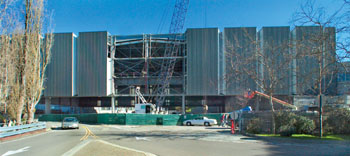 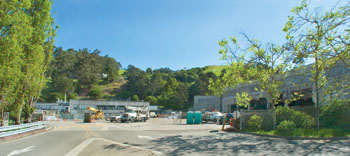 |
|
| EPB Hall, circa January (top) and today. | |
Actually, the history remains. It’s the shell of that history that is, well, history. And now about 43,900 square feet of land adjacent to the venerable Bevatron, whose 40-year contribution to particle physics is legendary, rests clean of its experimental and storage residue. What was once a hulking, football-field-sized, six-story-high warehouse is now flat ground.
Built in 1967, the massive industrial high-bay was removed with alacrity by the Evans Brothers Inc. construction company. About 1,670 tons of material was removed, of which 325 tons were recycled and 1,150 tons were salvaged.
“Teamwork, thorough pre-planning and patient execution — with one eye on the budget, the other on the schedule — and a vigilant focus on safety was the combination that led to successful completion,” said Project Director Margaret Goglia. And she especially thanked Lab members of the team — Project Manager Richard Stanton, jobsite superintendent John Patterson, Ron Acord, Fred Angliss, Sally Cherene, Rob Connelly, Laura Crosby, Mike Dong, Ross Fisher, Sabah Hassan, Dan Kevin, Tamara Krymskaya, Ginny Lackner, Willie Lopez, Nick Peterson, Gary Piermattei, and Loretta Valentine.
“Personnel from Facilities Division partnered with colleagues in EH&S and procurement to address compliance with a myriad of regulations governing the work,” Goglia said. “A collaborative tone was struck with both the consulting engineering firm (Winzler & Kelly) and the Evans Brothers.
“And, of course,” she added, “nothing could be done without support from the DOE Berkeley Site Office, especially Dick Nolan and Warren Yip, and the DOE headquarters excess facilities program led by David Michlewicz.”
According to facilities planners, the newly cleared area will probably be used in the near future for much-needed parking and lay-down areas. Its long-term status is uncertain, dependent upon Laboratory priorities and federal funding.
Kids Can Glimpse Life on the Hill at ‘Daughters and Sons’ Event
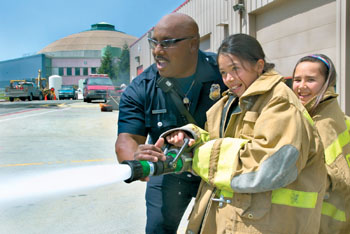 |
|
| Last year, Kevin Johnson, with the Lab's fire station, gave “Take Our Daughters and Sons to Work Day” participants some tips on dousing flames. |
How does one explain to a child the work that goes on at Berkeley Lab? The best way is to bring them here, so they can see for themselves what it takes to produce world-class research.
Employees can do just that on Thursday, April 22, as the Lab hosts its annual “Take Our Daughters and Sons to Work Day.” Organized by the Lab’s Center for Science and Engineering Education (CSEE), the day will be filled with fun activities for boys and girls ages 9 to 16.
While the Lab has sponsored this event for nearly a decade, this year’s version will feature a new structure, explains Rollie Otto, CSEE director.
“We reviewed the participation data from the last few years and found that the boys outnumber the girls at about a 2-to-1 ratio,” he says. “We want to encourage greater participation of girls, and it was suggested that we try separate workshops for boys and girls to achieve that goal.”
A number of science workshops will be offered — girls will attend these in the morning, boys in the afternoon — allowing participants to learn such things as how windows are made more energy efficient, or the freezing properties of liquid nitrogen. They can also take a virtual visit to Mars, work with micro machines, or help build a robot.
The workshops are for children only. Adults can interact with their guests during lunch or at the ice cream social at the conclusion of the event.
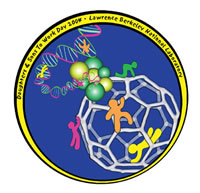 |
|
“Another new component we’ve added this year are two ‘Women in Science’ career fairs,” Otto says, “one for the boys in the morning, and one for the girls in the afternoon. This will allow the kids to see what kind of jobs are performed here and meet women role models.”
Otto is seeking volunteers from all professions at the Lab to speak — along with displays or handouts, if possible — at the career fairs. Vol-unteers are also needed to serve as chaperones (escorting the children between activities), and to help with registration, lunch, and the ice cream social. To volunteer, call x5816.
Employees interested in having their children, or those of friends or families, participate must fill out a registration packet (available on the CSEE website and in the cafeteria). The packets must be turned in by April 9. The cost is $20 per guest, which includes a barbecue lunch and t-shirt.
More information is available at the CSEE website www.lbl.gov/Education/CSEE/.
— D. Lyn Hunter
Putting Some Distance Into Magnetic Resonance Imaging
Remote Detection Makes MRI Versatile and Sensitive
BY PAUL PREUSS
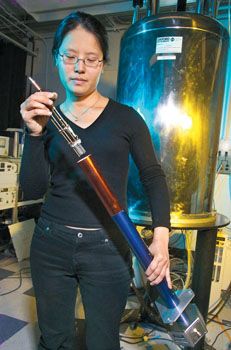 |
|
| Song-I Han holds a probe incorporating separate encoding and detection coils, which will be placed in the high-field magnet behing her. A large encoding coil is located near a small, highly sensitive detection coil. Polarized xenon gas carries the MRI information from the encoding coil to the detection coil. |
Mention MRI to most people and they think of a hospital room where a big, noisy machine swallows patients whole and takes pictures of their insides while they lie flat on their backs, holding their breath and trying not to scratch what itches.
While imporant, medical diagnosis is just one of MRI's many applications. MRI (magnetic resonance imaging) and its underlying technology, NMR (nuclear magnetic resonance) perform a raft of functions including analyzing chemicals, logging oil wells, studying material surfaces and structures, and discovering new drugs.
“NMR encoding is exceptional at recovering chemical, biological, and physical information,” says NMR/ MRI pioneer Alexander Pines of Berkeley Lab's Materials Sciences Division, a professor of chemistry at UC Berkeley. “The problem with this versatile technique is low sensitivity.”
It's a problem exemplified by big medical MRI machines. Enough data to picture a slice through a human body requires a huge magnet and a radiofrequency (RF) coil big enough to surround the target. When the same big coil is used to detect MRI data, sensitivity blurs.
Now Pines and his colleagues have discovered a remarkable new way to improve MRI's versatility and sensitivity by physically separating signal encoding and detection, using laser-polarized xenon gas as the medium for “remembering” the encoded information and carrying it to the remote detection site.
Early experiments by Pines and a group of his postdocs and graduate students, Adam Moulé, Megan Spence, Song-I Han, Juliette Seeley, Kimberly Pierce, and Sunil Saxena, were described last August in Proceedings of the National Academy of Sciences; recent advances are reported in the Journal of Magnetic Resonance.
NMR works because many atomic nuclei act like toy bar magnets with north and south poles. The spinning nuclei orient themselves along magnetic field lines, spins up or down, with slightly more energy required to maintain the spin-down state.
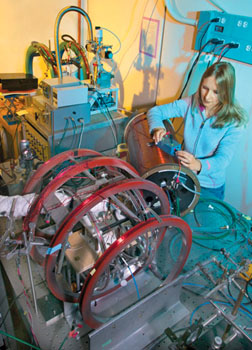 |
|
| Juliette Seeley works with a remote-detection assembly that can encode images in a low magnetic field and detect them with highly sensitive non-NMR detectors. A xenon polarizer provides a continuous flow of sensor gas to the encoding probe and then to the remote optical detector. | |
During encoding, an RF pulse matched to the energy difference knocks the nuclei atilt, causing the spins to precess around the main magnet's uniform field lines like leaning toy gyroscopes. Precession rates are characteristic of each chemical species — ubiquitous hydrogen is used most commonly — and are also affected by chemical and physical surroundings.
For MRI, an extra step encodes position data by using additional magnets to briefly superimpose fields that are stronger in one direction than the other. The field-strength differences create a unique set of coordinates by changing the angles and speeds of precession when the target nuclei are subjected to RF pulses.
Many factors affect the best ways to encode and detect information about a particular sample, including the strength of the magnetic field, the size of the coil, and the proportion of target nuclei in the sample — if the proportion inside the coil is small, this small “filling factor” makes for a weak signal.
Polarization is also vital. Even in a strong magnetic field, the detectable excess in the number of spin-up versus spin-down hydrogen nuclei is at best 1 in 100,000. Xenon, however, can be optically “hyperpolarized” to some 20-percent excess spin-up, before being introduced into a sample where the xenon nuclei interact with their surroundings to encode information.
A big RF coil and a strong magnetic field are often best for encoding, while sensitive detection might require a smaller coil — or even a supersensitive, non-MRI detector like a superconducting quantum interference device (SQUID) or a laser magnetometer.
Conversely, weak magnetic fields are better for encoding some subjects — for example, patients with pacemakers or metal implants — but signals encoded in a weak field can only be recovered by a high-field detector.
“By separating the encoding and detection phases of NMR/MRI, we can gain data about physical, chemical, and biological properties of samples that we simply could not have gotten previously,” says Song-I Han.
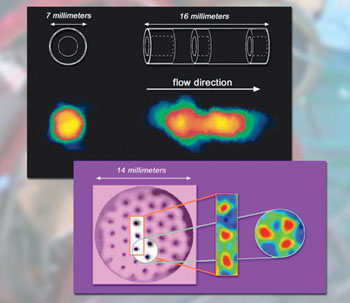 |
|
| (Background) In the pioneering experiment, the interior arrangement of a plastic tube with Teflon inserts was encoded by xenon gas in a low magnetic field, then carried 15 feet to a detector in a high field and analyzed to reconstruct the image. (Foreground) In a more recent experiment, a “honeycomb” of perforated plastic (pink) was encoded in one coil and detected in a separate, more sensitive detector, both in a high magnetic field. The disk's pore structure was accurately reconstructed from 10 batches of polarized xenon. |
“This is possible because nuclear spins have the ability to retain memory of their prior surroundings,” Juliette Seeley adds. “They remember the information that was encoded in an environment not optimized for detection, and later they can be detected more sensitively.”
“We were able to demonstrate the rather fantastic notion that a picture of a sample cell could be obtained by saturating it with xenon gas,” says Sunil Saxena, now at the University of Pittsburgh, describing early attempts at remote detection, “and then moving the gas — by as much as 15 feet — to another spectrometer for signal detection. The xenon gas faithfully remembered the shape of the sample cell.”
More recently, encoding and detection coils have been placed closer together but still physically separated, both in the same strong magnetic field. Using a much smaller detector coil greatly enhances the filling factor, because the coil surrounds only the target nuclei, not the entire sample.
Recent results are reported in “Remotely detected high-field MRI of porous samples,” by Juliette A. Seeley , Song-I Han and Alexander Pines, in the Journal of Magnetic Resonance, April 2004.
New Look at Biomineralization
STXM Allows Study of Bacteria in Real-Life Conditions
BY LYNN YARRIS
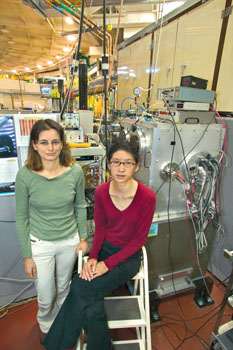 |
|
| Sirine Fakra and Clara Chan used the STXM at the Molecular Environmental Sciences’ newly commissioned ALS beamline 11.0.2 to get a new look at the relationship between microbes and the process of biomineralization. | |
Images taken at the ALS Molecular Environmental Science’s newly commissioned beamline (11.0.2) helped provide a fresh new look into the ancient but still mysterious process of biomineralization. Microbes, extracted from the flooded tunnels of an abandoned iron mine, were found to be producing mineralized nanocrystal filaments that are a thousand times longer than they are wide. The formation of these astonishingly elongated nanocrystals is comparable to the process by which nature forms bones, teeth, shells, and other durable substances. Humans have never been able to fully mimic this process.
Jillian Banfield, who holds a joint appointment with Berkeley Lab’s Earth Sciences Division and UC Berkeley’s Department of Earth and Planetary Sciences, was the co-leader of this project along with Gelsomina De Stasio, of the University of Wisconsin’s (UW’s) Synchrotron Research Center in Madison. Banfield began the research while she was a faculty member at UW’s Madison campus. Berkeley Lab’s Sirine Fakra, an ALS beamline scientist, and UC Berkeley’s Clara Chan obtained images at the MES using the Scanning Transmission X-Ray Microscope (STXM), which offers the best spatial and spectral resolution currently available for STXM imaging.
Says Fakra, “With our STXM, you can study bacteria and biomineralization under conditions that are very similar to their native environment. The high flux of beamline 11.0.2 combined with the scanning speed, and spatial and spectral resolutions of the STXM enable us to quickly acquire data from hydrated samples at atmospheric pressure.”
STXM images taken at the ALS, in combination with x-ray photoelectron emission spectroscopy (X-PEEM) and other x-ray images taken at the Wisconsin synchrotron, revealed the presence of an organic polymer template, secreted by the microbes, that guided the crystallization of an iron-oxide mineral called akaganeite. The microbes were collected from an iron oxyhydroxide-encrusted biofilm that scuba divers had plucked from the now underwater tunnels of the Piquette Mine in Tennyson, Wisconsin.
Says Banfield, “We’re dealing with microbes that probably oxidize ferrous iron and reduce oxygen. The product, ferric iron, then precipitates along the polymer templates which are attached to the microbial cell membranes.”
The results are akaganeite crystals that measure only a couple of nanometers wide, but up to about 10 microns in length. Banfield says that a better understanding of how the microbes are able to template mineral crystallization could lead to the fabrication of new materials through biomimetic synthesis. A better understanding of biomineralization could also provide new ways of looking for evidence of past life on Earth or on other planets.
“The crystal fibers we observed are unusual primarily in their large aspect ratio,” says Banfield. “They can be visualized as having the same proportions as a human hair.”
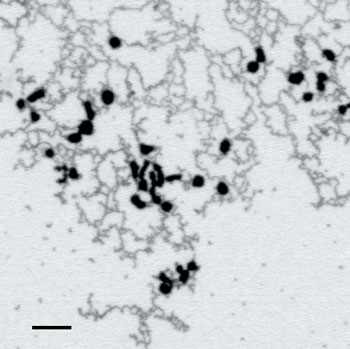 |
|
| Researchers used the new Scanning X-ray Transmission Microscope at the ALS to test whether polymer filaments secreted by microbes serve as a template for biomineralization. This STXM image confirmed that iron-oxide mineral deposits (shown as dark clumps) form on top of the filaments, as the researchers predicted. |
It has been well-documented that under saturation conditions, microbes can trigger the formation of minerals. However, the process by which biomineralization takes place has been a puzzle. In a paper reporting their research findings, which appeared in the March 12, 2004 issue of the journal Science, the Berkeley-Wisconsin collaborators say that mineralization occurs when the polymer strands secreted by the microbes come in contact with oxidized iron.
Says Chan, “We’ve been analyzing the chemical interactions between the polymer and iron but we need spectroscopic information which is what we are working on now. With the STXM we can certainly see evidence of a polymer-mineral interaction.”
In their Science paper, Chan and her co-authors speculate that the microbes secrete the polymer strands as a means of enhancing their ability to produce energy.
The STXM used in this study is an upgraded version of an earlier instrument attached to ALS Beamline 7.0.1, a multipurpose beamline not optimized for imaging. Beamline 11.0.2 was designed to meet STXM operational requirements. Its current parameters include a photon-energy range from 150 eV to 2000 eV, a flux of up to one billion photons, a spot size of about 30 nanometers, and a spatial resolution sufficient to see details in 25-nanometer patterns.
Says Fakra, “The STXM at the ALS is now the best instrument available for performing spectroscopy and imaging at high spatial and spectral resolutions on samples in real life conditions. We hope our results will encourage other studies on biomineralization.”
In addition to Banfield, De Stasio, Chan and Fakra, other co-authors of the Science paper were Susan Welch, Maria Nesterova and Bradley Frazer of UW-Madison, and Marco Girasole of the Instituto di Struttura della Materia, Consiglio Nazionale delle Ricerche, in Rome.
Director Shank Answers Most Frequent Questions About Berkeley Lab's First Contract Competition
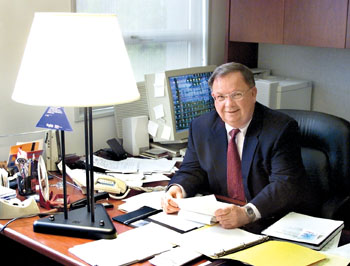 |
|
| Lab Director Charles Shank | |
As Berkeley Lab faces its first-ever competition for a management contract — one that has been under the University of California’s control for more than 50 years – employees are understandably concerned about what it all means, for the laboratory and for them. Lab Director Charles Shank, who will be assisting his successor in the process as he prepares for his departure from the Lab later this year, sat down with The View and provided his personal opinion on some of the most frequently asked questions about contract competition.
Why is the competition happening at Berkeley Lab?
Shank: Our laboratory was founded in 1931 on the Berkeley campus, and in 1943 it was designated a national research facility to be operated by the University of California under contract with the Atomic Energy Commission. Every five years, the Department of Energy (successor to the AEC) has reevaluated the contract to make a determination on whether to extend or compete it. On every occasion, the DOE has chosen to extend – including the contract in the most recent time frame.We were very close to having a contract that would have assured the University’s leadership for another five years, but Congress intervened and listed Berkeley, Ames, Livermore, Los Alamos and Argonne as labs whose contracts must be competed because none had undergone competition in the last 50 years. To my knowledge, this is the first time that the DOE has ever competed a lab following its own decision to extend a contract.
Congress has taken this action because of the strongly held belief that competition is good and will bring about a better result for the American people.
What is Berkeley Lab’s position on competition?
Shank: The Laboratory will be fully involved in the response to the Congressional mandate. Congress funds the laboratories, and it’s Congress that has required the competition to take place, so we need to respect that. We will respond appropriately.How are the Lab and the University preparing for competition?
Shank: It is clear to me that Con-gress and the Department of Energy expect the University of California to take this competition very seriously. UC Vice President (Robert) Foley said as much in a letter to the Office of Science. (“The University has had a long history with the Laboratory, and we look forward to continuing it in the future,” Foley wrote). He made it clear that the University is willing to level the playing field to the extent practicable.This Lab is among a very small number that are built on university land and closely integrated with university operations. Since the DOE has already been on record with a positive statement on contract extension, the University is well positioned to enter the contract competition. And I expect the Regents to do so.
What does that mean for Berkeley Lab and for its employees?
Shank: It means that it is un-likely we will have a bidding competitor. It does not mean, however, that there will not be a competitor. It means that we will prepare for the competition as if we were facing competitors, but most likely we will be competing with ourselves.This is a difficult position for the University to be in, because at the end of this process, no one has the satisfaction of being declared the winner. It also means there is great pressure to produce a competitive proposal that is recognized as excellent by the DOE and by Congress. It is my hope that the government will have derived a positive value from the process, that the DOE will recognize that the University has stepped up with an improved organization, and that the University will benefit from a strengthened partnership with the DOE into the future.
What’s next in the process?
Shank: The DOE is establishing a Source Evaluation Board (for the competition). I would expect the DOE request for proposals (RFP) by the May timeframe. At that point, the process is initiated and I expect will be completed by the end of the calendar year. Along the way, the Lab will be providing input to the (University of California) Office of the President as it prepares a competitive proposal.What can employees expect if a new manager takes over Berkeley Lab?
Shank: I think that (this outcome) is a low probability. And although the impact to employees in unknowable, I would expect conditions under a new manager to be substantially similar to what they are under the current contract.How will you be involved in the process?
Shank: The University is on a fast track to identify a new Director, and that person will have to be a participant as part of the competition. My role will be to support the new Director and help in any way I can to facilitate a positive outcome in the competition.
Gene-Rich Human Chromosome 19 Sequence Completed
BY DAVID GILBERT
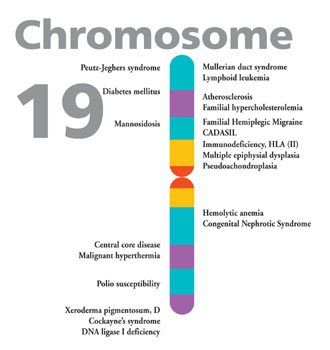 |
|
The Department of Energy’s Joint Genome Institute (JGI) and Stanford University have completed the sequencing of human Chromosome 19, the most gene-rich of all the human chromosomes. This achievement is described in the most recent edition of the journal Nature.
“Culminating 18 years of research, this partnership exemplifies DOE’s commitment to advancing our understanding of the complex interplay between our human health and the environment,” said Energy Secretary Spencer Abraham, whose agency funded the work through the Office of Science.
Embedded in this sequence information are critical regulatory networks of genes tasked with controlling such functions as repairing DNA damage caused by exposure to radiation and other environmental pollutants. Studies of DNA-repair genes, initiated at the DOE national laboratories, are yielding insights into the development of certain cancers, many of which appear to be caused by defects in DNA-repair pathways. Also, new insights are being gleaned about other gene families implicated in detoxifying and excreting chemicals foreign to the body.
“With this high-quality sequence now made freely available to the scientific community, more light will be shed on individual responses to medicines,” said Abraham. “This will enable the development of more sensitive diagnostics for susceptibility to a wide array of important diseases. In time, with this information in hand, physicians will be able to tailor more effective individualized therapeutic strategies.”
Chromosome 19, at 55.8 million bases, or letters of genetic code, although representing only about two percent of the human genome, features nearly 1,500 genes. They include genes that code for such diseases as insulin-dependent diabetes, myotonic dystrophy, migraines and familial hypercholesterolemia (high levels of cholesterol in the blood) that increases the risk of cardiovascular disease.
“Beyond the significant revelation that Chromosome 19 has more than twice the gene density of the genome-wide average, it also offers a fertile landscape for exploring evolutionary motifs,” said JGI Director Eddy Rubin. “An intriguing picture has emerged regarding conservation and divergence, revealing large blocks of gene conservation with rodents as well as segments of coding and noncoding conservation with more distant species such as the pufferfish, Fugu rubripes, which was also sequenced here at the JGI. While not long ago these noncoding regions were considered nonsense, now they are actually proving to have powerful regulatory influence over the genes that they bracket.”
The DOE originally selected Chromosome 19 as a sequencing target because of the agency’s mission of investigating the link between DNA damage from radiation exposure and human cancer. Initial work conducted by Lawrence Livermore National Laboratory in the mid 1990s led to the mapping of multiple DNA repair genes on Chromosome 19. In 1999, the sequencing and finishing project was transferred to the JGI and the Stanford Human Genome Center respectively.
“Unlike earlier draft human genome sequences, this version is 500 times better in terms of contiguity and accuracy — which makes a huge difference if you are trying to do biology with that sequence,” said Richard Myers, director of the Stanford Human Genome Center. “It gives you a sense of the chromosome’s topography — one filled with such biologically interesting features as transcription factors, olfactory receptor genes, and zinc finger genes.”
Olfactory receptors represent the largest multigene family in higher organisms, which have evolved in response to the need for animals to recognize millions of odors—both threatening and attractive—in its environment. Transcription factors are proteins that need to be recognized by RNA polymerase in order to initiate the elaboration of nucleotides along the DNA molecule. Zinc finger proteins are chains of amino acids that capture a zinc ion and bind to RNA or DNA and play a critical role in a cell’s life cycle. These proteins regulate the expression of genes as well as nucleic acid recognition, reverse transcription and virus assembly. Drug development efforts seek to disrupt these zinc finger structures to prevent viruses from functioning.
Chromosome 19, however, was not without its challenges, Myers added. “The sequence was harder to work through than expected. It was highly repetitive, with high GC (base pairs) content. It’s a real tribute to this team that they could get the sequenced finished.”
Stanford’s role in the collaboration is the critical one of “finishing” the DNA sequence. The finishing process ensures that the information made available through the public databases is completely contiguous, with all ambiguities resolved. This painstaking process begins with the electronic transmission of draft data sets, some 20 billion bytes per week, and shipping of bacteria culture plates from the JGI’s Production Genomics Facility to Stanford.
“To get this level of confidence several iterations of the genome sequence is required, typically at six to eight times coverage,” Myers said. In areas that fail to meet the required quality standard, directed finishing reactions of many different types are performed and the resulting data incorporated back into the draft assembly. Only after rigorous scrutiny, when all data has been extensively reviewed by a human finisher, and all gaps and low quality areas have been resolved, will the sequence data be posted on the public databases. The quality of the finished chromosome 19 sequence far exceeds the 1-in-100,000 base pair error rate set by the International Human Genome Sequencing Consortium, with the error rate estimated to be much less than1-in-100,000 base pairs.
Markowitz Tapped for JGI Chief Informatics Officer
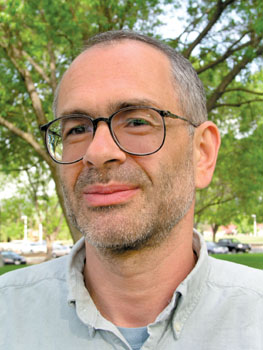 |
|
| Victor Markowitz | |
The Joint Genome Institute (JGI) recently announced the appointment of Victor Markowitz to the newly created position of Chief Informatics Officer. He returns to the national laboratory environment where he spent a decade developing genomic software tools before a six-year stint in industry.
“Among the challenges Victor will address is the development of more efficient systems for managing the tremendous flow of data from the sequencing effort at the JGI,” said JGI Director Eddy Rubin. Having recently surpassed two billion bases of sequence information generated per month — spanning mammals, plants and microbes — the JGI is among the world’s leading producers of genomic data.
“Victor’s first project with JGI is to capture the sequence extracted from natural environments into a system that will enable not only microbiologists, but geologists, chemists, environmental scientists, and others to mine this data. This effort should provide insights into the role that these microbes play in the health and wellbeing of the biosphere,” Rubin said.
Markowitz also serves as the head of the recently established Biological Data Management and Technology Center (BDMTC), within the Computational Research Division (CRD) at Berkeley Lab. He intends to apply industry practices to developing robust systems for managing the increasingly complex data being produced by life sciences groups. He is also involved in a UC Berkeley proposal to establish a National Center for Biomedical Computing, where BDMTC will provide the data management and software development resources. Markowitz’s goal is to get the new center involved in a number of collaborative projects, then share both his group's expertise, tools and results among collaborators.
“The key to tapping into the rich data generated by the human genome project and other sequencing efforts is informatics, and the research community is indeed fortunate to have someone of Victor Markowitz’s knowledge and stature in the position of Chief Informatics Officer for the Joint Genome Institute,” said Computational Research Division Director Horst Simon. “Victor's experience as a member the research community, coupled with his knowledge of private sector practices, makes him the logical choice for this position.”
Prior to joining JGI and CRD, Markowitz served as Chief Infor-mation Officer and Senior Vice President, Data Management Systems, at Gene Logic Inc. Markowitz was responsible for building Gene Logic’s data management, software development, applied bioinformatics, and IT organization. He directed the development of Gene Logic’s data management products, including its flagship Genesis data management platform for gene expression data used by pharmaceutical and biotech companies worldwide.
Flea Market
- AUTOS & SUPPLIES
99 HONDA CIVIC, silver/gray inter, 57K mi, exc cond, ps, pb, abs, pwr wind & drs, CD, alarm, moon roof, new tires, $9,700/bo, Marek, X5029, 582-5867
95 TOYOTA VAN PREVIA, 88K mi, pearl wht exterior, auto trans, pwr wind, locks, steering, cruise control, dual A/C, good cond, supercharger, original owner, exc for mountains & families, $6,500/bo, Ed, X6047
94 MERCURY VILLAGER minivan, V6, top of line, all pwr, 122K mi, exc cond, original owner, all records, recent service, $4,500, Bill, X7271, (925) 377-6117
91 MERCEDES 190E 2.6, sunroof, new champagne paint, exc Michelins, garaged, maint records, A/T, air, 6 cyl, clean, 139K mi, $5,150/bo, Dick, (925) 284-5236 before 9 p.m.
89 FORD PROBE GL, 116K mi, 2 dr hatchback, 5 spd stick, pwr steering, runs well, smogged, $1,200, Owen, X5462, 655-8498
64 FORD F-100 pickup, short bed, auto, limited slip rear end Dana, custom cab, new under hood wiring/radiator & many extra parts, requires minor assembly to run, $1,500/bo, Jerry, X4165, 625-9308
MOTORCYCLES
02 Ducati 620ie, yellow, 5K mi, perfect city bike, beautiful, dual front brakes, rubberized pegs, fairing, rear seat cowling, $4,995, Bob, 304-3711
HOUSING
BERKELEY, Carleton/Grant, nr BART/ shops/Lab shuttle, close to LBL, newly renov 2 bdrm apt, grnd flr of 2 story Victorian house, sunny southern exposure, front garden, w&d, custom tile flrs, no smoking/pets, $1,400/mo, incl part utils, avail immed, Richard or Hope, 845-1723
BERKELEY, HEARST COMMONS 1146-1160 Hearst, studio townhouses w/ decks, hrdwd flrs, skylights, dw, ac, sec, wired for cable/sat, major pieces of furn can be provided, Ian, 220-2051, $775/mo, hearstcommons@jps.net for pictures
CENTRAL BERKELEY, nice furn rms, kitchen, laundry, PC, DSL, hrdwd flrs, brkfst, walk to campus/shops, $800/mo incl everything, Paul, X7363, 845-5959, jin.young@juno.com,
EL CERRITO, quiet res area, partially furn 3bdrm, 1bth house to share, new hrdwd flr, freshly painted, lge fenced yrd w/fruit trees, lge storage shed, nr shop/BART/pub trans, avail now, no smoker/pets, Female, $600 + util, some sec dep, Shirley, 643-1433, shirleychi@ssl.berkeley.edu
HERCULES, 3bdrm, 1bth, newly modeled, lge yrd, garage, close to school/park/ shopping & pub trans, $1,795/mo + dep, no pets, Betty, 245-7517, 642-8638
NORTH BERKELEY, furn rm in 4bdrm house, on Euclid/Cedar, view of SF & Golden Gate, laundry & cooking facilities, nr campus & LBL shuttle, $650/mo, Glenda, 548-1287
NORTH BERKELEY, furn studio, avail 4/2, $750/mo, Rochelle, 548-0431
NORTH BERKELEY, 1bdrm upper flat, fully furn, nr Glendale & Campus Dr, carpeted, laundry, deck, fp, parking for 1 car, no pets/smoking, $1,100/mo + dep & util, avail 4/2, Rochelle, (415) 435-7539
NORTH BERKELEY HILLS, studio apt, newly refurbished, prvt entr w/sml deck, wonderful tree house feeling, semi furn, mo to mo lease, stairs, no smoking/pets, nr pub trans, parking & util incl, $925/mo, avail 6/7, Darlene, 527-7732, lrw7732@pacbell.net
NORTH OAKLAND, rm avail in 3bdrm apt on Alcatraz nr Telegraph, BART/grocery, nice apt complex w/yrd, patio, parking, mo lease, $600/mo, rent + $735 dep, Owen, X5462, 655-8498
OAKLAND 2 story townhouse, 3bdrm, 2.5bth w/Jacuzzi in master bth, 2 car garage, nr Lake Meritt, walk to BART, fp in the liv rm, pvt patio, loads of closet space, fridge, dw, w&d, $1,950/mo, 2638 Harrison Street, Julia, X4302, 749-9974
OAKLAND HILLS house, 20 mins to LBL, quiet, sunny & secluded, just remodeled, new rug, skylights & jacuzzi tub, 2bdrm, 1bth, stove, carport w/additional parking, sml yrd for potted plants, sml wooden deck landing, lge storage cabinets, no pets, $1,500/mo, 1st & last mo & dep $1,500, Yoshy, X7195, yyminamihara@lbl.gov
OAKLAND/Montclair sabbatical rental, spacious, fully furn new house, 2 bdrm, 2.5 bth, 3rd bdrm neg, fp, 2 decks+patio, views, quiet street, DSL, friendly cat, 15 min UCB, $2,200/mo+dep, avail 8/1 for 1 yr, Peter, X5413, pmjacobs@lbl.gov
PINOLE, 3bdrm, 2bth, pet friendly home, fenced yrd, dog run w/garage access, 1 blck from park, hot tub, w&d, fp, 2 car garage, view, great landscaping, $1,900/mo, Erik, 910-4318, erpage@lbl.gov
HOUSING Wanted
NORTH BERKELEY/Berkeley Hills for visiting NYC executive/research couple,
2-3 bdrm, furn house for 7/04, good references, non smokers, Jerry, (212) 722 6888, jpfuchs@earthlink.net clonzisero@hotmail.com
NORTH BERKELEY/Berkeley Hills for visiting NYC executive/research couple, 2-3 bdrm, furn house for 7/04, good references, non smokers, Jerry, (212) 722 6888, jpfuchs@earthlink.net
SHORT TERM housing for 6/1 – 7/04 for visiting LBL scientist & wife, prefer 1bdrm apt in So Berkeley/Rockridge, but open to all options, Tom, X6513, tcrawfor@oddjob.uchicago.edu,
MISC ITEMS FOR SALE
BIRDCAGE w/wire form flr & detachable base plastic tray, 30 x 30 x 17.5, 1 lge frontal access dr & 2 sml side access drs, 3 climbing ladders, ideal for pet rodents needing more space to play, wire form flr is removable, $40/bo,Yeen, X7580
BLACK LEATHER COAT, size 3X, $70, Stephanie, X7058
CONCERT TICKETS, 4/17/04 at the HP Pavilion, sec 114, row 20, seats 4 & 5, $107, for both, Wes or Jane, (415) 898-2084
ENTERTAINMENT CENTER, Low Slung, exc cond, blk wd, glass drs, 18x35x18, $75/bo, Jon, X5974
FUTON, double sized, base is 3 piece wood design, mattress is firm & robust, price $95, best for use as a bed, Geoff, 428-9614 or Jon, X5974
NEW KENWOOD KRC 2006 receiver, am/fm/cassette, sep bass & treble, RCA preouts, Dolby NR, 2 knob shafted radio for your classic car or truck, adjustable shafts fit most openings, $175, cash or USPS money order, Jerry, X4165, 625-9308 evening
NIKON 35mm film auto focus camera, 35-70mm zoom w/red eye reduction & self timer features, good cond, $65/ob; twin size bed w/mattress, box, frame, bed skirt, good cond, $95/ob; double seat greenish pattern cloth cover sofa, good cond, $95/ob; full size futon w/blk metal frame, good cond, $115/ob; 847-5130
MIRRORED OAK WOOD DRESSER w/shelves, 6 drawers & pattern etched into wd, $500, Marcia, X6698
PORTABLE GENERATOR, 4200W continuous, 5250 peak, Honda 8HP commercial grade OHV, 2x20A, 1x30A, never used except to run once a yr & drained, stored under tarp, runs good, manuals, $250, Eric, X7183, 237-9909
TWO tricycles, for 2-3 yr old; 2 children's bicycles for 4-5 yr old, good shape, reasonable, Joe, X7082, yjhuang@lbl.gov
FREE
DOLL HOUSE & furn collection, free to a good home, but you must take everything, Will, 522-7024, X5689
FOUND
MEMOREX 64MB flash memory found in the cafeteria on 3/18, Stefano, X4726
WANTED
USED sewing machine, nothing fancy, Joern, X2407
WOODWORKING HAND TOOLS, Inexpensive wood working hand tools for 7 yr old children, Joe, X7082, yjhuang@lbl.gov
VACATION
LAKE TAHOE, house, 3bdrm, 2 1/2 bth, fenced yrd, quiet sunny location, skiing nearby great views of water & mountains, $195/night, 2 night min, Bob, nbs@value.net, (925) 376-2211
SO LAKE TAHOE, spacious chalet in Tyrol area, close to Heavenly, peek at the Lake from front porch, fully furn, sleeps 8, sunny deck, pool & spa in club house, close to casinos & other attractions, $150/day + $75 one time clean fee, Angela, X7712 or Pat or Maria, 724-9450
Flea Market Policy
.Ads are accepted only from Berkeley Lab employees, retirees, and onsite DOE personnel. Only items of your own personal property may be offered for sale.
Submissions must include name, affiliation, extension, and home phone. Ads must be submitted in writing (e-mail: fleamarket@ lbl.gov, fax: X6641,) or mailed/delivered to Bldg. 65.
Ads run one issue only unless resubmitted, and are repeated only as space permits. The submission deadline for the Mar. 19 issue is Friday, Mar. 12